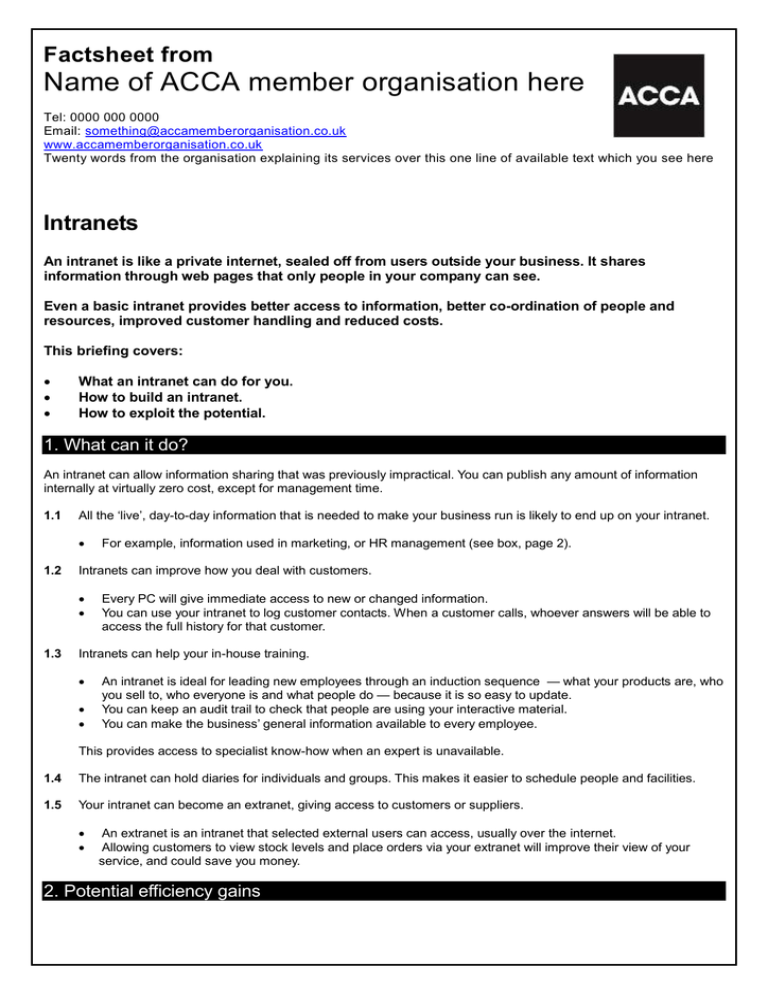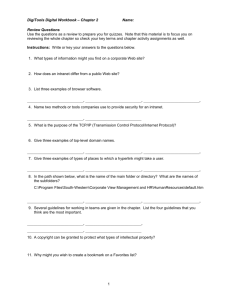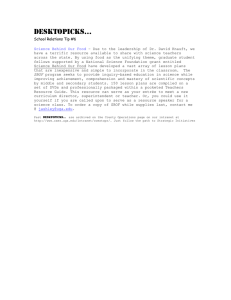
Factsheet from
Name of ACCA member organisation here
Tel: 0000 000 0000
Email: something@accamemberorganisation.co.uk
www.accamemberorganisation.co.uk
Twenty words from the organisation explaining its services over this one line of available text which you see here
Intranets
An intranet is like a private internet, sealed off from users outside your business. It shares
information through web pages that only people in your company can see.
Even a basic intranet provides better access to information, better co-ordination of people and
resources, improved customer handling and reduced costs.
This briefing covers:
What an intranet can do for you.
How to build an intranet.
How to exploit the potential.
1. What can it do?
An intranet can allow information sharing that was previously impractical. You can publish any amount of information
internally at virtually zero cost, except for management time.
1.1
All the ‘live’, day-to-day information that is needed to make your business run is likely to end up on your intranet.
1.2
Intranets can improve how you deal with customers.
1.3
For example, information used in marketing, or HR management (see box, page 2).
Every PC will give immediate access to new or changed information.
You can use your intranet to log customer contacts. When a customer calls, whoever answers will be able to
access the full history for that customer.
Intranets can help your in-house training.
An intranet is ideal for leading new employees through an induction sequence — what your products are, who
you sell to, who everyone is and what people do — because it is so easy to update.
You can keep an audit trail to check that people are using your interactive material.
You can make the business’ general information available to every employee.
This provides access to specialist know-how when an expert is unavailable.
1.4
The intranet can hold diaries for individuals and groups. This makes it easier to schedule people and facilities.
1.5
Your intranet can become an extranet, giving access to customers or suppliers.
An extranet is an intranet that selected external users can access, usually over the internet.
Allowing customers to view stock levels and place orders via your extranet will improve their view of your
service, and could save you money.
2. Potential efficiency gains
2.1
Transferring data is quick and easy.
2.2
People in different locations can work together more effectively.
2.3
You can achieve guaranteed viewing of important documents (like new HR policies) by requiring employees to
confirm through the intranet that they have read them.
The intranet gives you flexible control over what is seen and by whom.
2.6
Data expertise and project work can be easily shared.
Links to FAQs, glossaries and other back-up resources can minimise mistakes.
Information is available 24/7, making flexible working more practical.
Intranet statistics can be analysed to reveal information about work patterns.
You can use existing IT systems efficiently.
2.5
‘Workspaces’ can be set up within your intranet. They allow several people to view and edit the same files and
send each other feedback.
An intranet can improve access to information in your business.
2.4
Information can be exchanged electronically rather than on paper.
You can achieve guaranteed viewing of ‘must’ messages on the home page.
You can have message bars on key pages, with company news in tickertape form.
Important information can be given direct to each individual involved.
Where necessary, access can be restricted by using password-protected pages.
Email address lists allow quick, selective distribution.
You can publish short-life information and set the system to remind you to delete it on a certain date.
An intranet may offer direct cost savings on printing and out-of-hours staffing.
3. How to do it
If you have a typical small-business LAN (local area network), an intranet may require little extra investment.
3.1
You can build an intranet from scratch yourself (see 4).
3.2
Use an off-the-shelf package (see 5).
3.3
The technologies underlying an intranet are the same as those which power the web. This means you can
build an intranet in the same way you build a website.
You need a server to host the intranet. If your business does not already have a server, this could cost less
than £1,000.
Many software firms offer intranet software which you can install onto your server.
The cost could be as little as a few hundred pounds, or even free if you use open source software. The more
functions and users you have, the higher the cost.
It is generally easier to buy a package than to start from scratch, but costs are higher and flexibility may be
more limited.
Use a hosted solution (see 6).
With a hosted solution, you pay a company to host your intranet on their servers.
You log in to the system to view and edit content and create the structure.
Hosted solutions are charged monthly. You will pay from £15 a month, depending on features and storage
space.
2
3.4
Pay an agency (see 7).
You can commission an agency to design and build your intranet from scratch.
This can cost from £500 upwards.
This is the best option if you need a highly customised intranet.
4. Building it from scratch
4.1
Setting up a simple intranet is similar to building a website. So if you run an office network and have web design
expertise in-house, you should be able to create a basic intranet easily.
4.2
You can use web design software to build your intranet pages.
4.3
For example, Adobe Dreamweaver or Microsoft Expression Web.
Costs may include buying hardware and software, plus the time of your employees.
You may need help from a consultant to build more complex features, like creating a live feed from your
customer database.
Management costs can be significant, particularly if you need to keep a lot of information up-to-date.
5. Off the shelf packages
5.1
You can install an off-the-shelf package onto your own server.
5.2
Although an off-the-shelf package is easier to set up, you will still need some knowledge of how to install the
package onto your server.
5.3
Most off-the-shelf packages simplify the process of creating an intranet by including templates and a graphical
interface which is easier to use.
If you lack the knowledge to do this, you can employ a consultant to set it up.
You may need to budget for technical support as well as for the software and hardware (if necessary).
6. Hosted solutions
6.1
With a hosted solution, your entire intranet resides on a server outside your business.
6.2
The hosting company takes care of technical issues, security, support and maintenance.
You log in to it to add pages, content and other elements to your intranet.
Many web-hosting firms offer hosted solutions.
Choose a reputable supplier — ask for recommendations and search the internet for reviews before signing a
contract.
6.3
The main benefit of a hosted solution is that all the technical issues are dealt with by the hosting company.
6.4
If a company already hosts your website, it may be best to use them for your intranet.
Look for a service agreement guaranteeing a fast response to technical problems.
Remember that you may store customer details and confidential information on your intranet, so make sure
the hosting firm is reliable and trustworthy.
Costs for a hosted solution are predictable and compare well with other options.
You will probably pay a fixed monthly cost.
Be wary of additional charges for support and data backups.
3
You may be charged extra for additional users, or if usage exceeds set limits.
7. Using an agency
An agency can build an intranet to fit your precise requirements.
7.1 Choose an agency carefully.
7.2
You will need to brief carefully, so that your business objectives stay to the fore.
7.3
Insist on seeing examples of previous intranet work for a company your size.
Design guidelines are important. An intranet must reflect your company’s style.
Get quotes and set limits on cost and time.
You may want to bring in an agency to do the initial work, then take over future updating and development
yourself.
8. Who looks after the intranet?
It is important to keep your intranet up-to-date, but be realistic about the resources required.
If out-of-date or contradictory information appears in different places on the intranet, people will quickly lose confidence
in it.
8.1
Make sure all users feel responsible for keeping pages that affect them up to date.
8.2
Content should come from all parts of the business.
8.3
Put the date created and date due for review on every page.
Intranet software can flag pages due for review. Be wary of using any features that delete old content
automatically — this may alienate whoever wrote it.
Encourage employees with writing skills to produce interesting material.
Some policing of the content will be necessary as the intranet grows.
9. Making it work
9.1
Make things on your intranet easy to find.
9.2
Keep the technical aspects of your intranet as simple as possible.
9.3
The user should never be more than three clicks away from the information.
Include a search page, so people can find what they want quickly. Most off-the-shelf packages and hosted
solutions will include search as standard.
Look for the solution which is easiest to use while providing what you need.
Look for a solution with good content management features.
If it is easy to change content, your staff will be more likely to use the intranet.
10. Get everyone involved
4
The more employees who use and contribute to your intranet, the more successful it will be.
10.1 Train all employees to use the intranet.
Demonstrate the benefits. Your staff must understand these.
Basic training only needs to be an hour long to get people started.
If you are using an agency, ask them to provide training as part of the deal.
10.2 Train non-IT people to use the authoring tools — at least one person in each office.
Most packages include a simple editing option similar to a word processor.
10.3 Identify enthusiasts who will help others to use the intranet and come up with ideas for developing it.
Find an ‘intranet volunteer’ to provide news and updates and be the local contact point.
What goes on your intranet?
Everything that is not highly confidential and that people will either need or want can justify a place on the intranet.
A.
People will need front-line information for dealing with customers. For example:
B.
They will need access to day-to-day operational information. For example:
C
Copies of current brochures and ads.
Research data, slides and presentations.
People will also need information about their jobs. For example:
E
Internal phone, fax and email directory.
Diary and scheduling information.
Company news.
Some will need marketing information and materials. For example:
D
Stock levels and parts lists.
Service and repair advice.
Help, glossaries and FAQs.
Background facts for new employees.
Details of HR procedures.
Health and safety information.
Company newsletter or magazine.
Suggestions and feedback forum.
It is usually non-business content that prompts employees to explore your intranet for themselves. For example:
Employees’ classified ads.
Details of colleagues’ work and interests.
Transport timetables and other local information.
What can you get at?
A major benefit of an intranet is the ability to access all kinds of information from many different systems and sources.
A.
You can add anything to your intranet.
Documents created in Word, Excel, Access or PowerPoint do not need to be changed.
5
As long as you have the software on your machine, you can click on the file and it will open up in its native format.
B.
Be wary of information overload.
Think carefully about the structure of your intranet.
Information may not be searchable if it is in documents you have uploaded.
Experts’ quotes
“Whilst intranets are sealed from users outside your business, blanket access to sensitive data should never be granted.
Access to such data should be tightly controlled, on a need-to-know basis.”
Paul Spearman,
3chillies
Expert contributors
Thanks to Paul Spearman (director, 3chillies, www.3chilllies.co.uk).
Further Help
Last reviewed 01.02.11
© BHP Information Solutions 2011. ISSN 1369-1996. All rights reserved. No part of this publication may be reproduced or transmitted without the
written permission of the publisher. This publication is for general guidance only. The publisher, expert contributors and distributor disclaim all liability
for any errors or omissions. Consult your local business support organisation or your professional adviser for help and advice.
6



